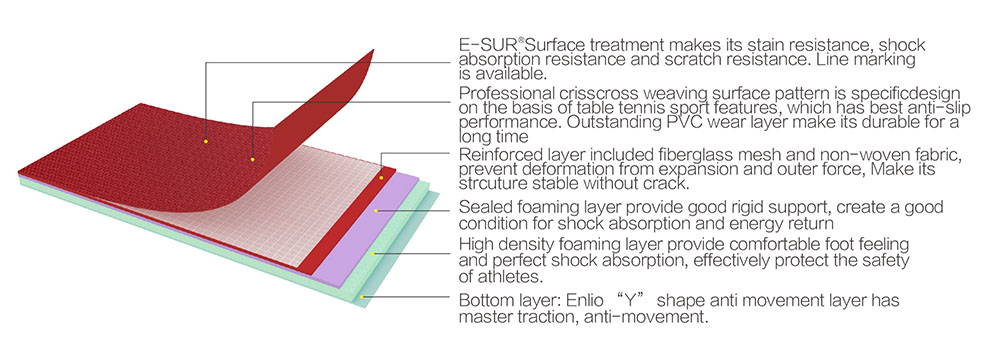ພ.ຈ. . 06, 2024 19:35 Back to list
Types of Indoor Basketball Court Surfaces and Their Characteristics for Optimal Play
Understanding Indoor Basketball Court Surfaces
Indoor basketball courts serve as the battlegrounds for countless hours of gameplay, training sessions, and competitive leagues. The type of surface on which basketball is played can significantly affect gameplay, player performance, and even injury risk. Therefore, it’s crucial for facility managers, players, and coaches to choose the right surface for their indoor courts. In this article, we will explore the various types of indoor basketball court surfaces, their features, and their impacts on the game.
Types of Indoor Basketball Court Surfaces
1. Wooden Floors Wooden surfaces are the gold standard for professional basketball courts. These floors, usually made from maple or oak, offer a combination of durability, aesthetics, and superior performance. The natural wood grain provides excellent traction, reducing the risk of slips and falls. Moreover, hardwood floors are known for their shock absorption qualities, which help decrease the impact on players' joints, making it easier on their bodies during intense games. However, wooden surfaces do require regular maintenance, including refinishing and sealing, to preserve their playing conditions and extend their lifespan.
2. Synthetic Floors Synthetic surfaces have become increasingly popular, particularly in multi-purpose facilities. These include products like vinyl and polyurethane. One significant advantage of synthetic surfaces is their versatility; they can be used for a variety of sports, making them an economical option for schools and community centers. Synthetic floors are generally easier to maintain compared to wood, as they resist moisture and don’t need regular sealing. However, they may not provide the same level of shock absorption and traction as wooden floors, which can affect gameplay.
3. Rubber Flooring Rubber flooring is another alternative that has gained traction, particularly among recreational facilities and schools. Known for its high durability and ease of installation, rubber flooring offers a softer surface that can be easier on athletes' joints. Additionally, it is slip-resistant, providing a safe environment for players. However, rubber surfaces can sometimes lack the same level of responsiveness and feel as wooden or synthetic options, which may impede high-level performance.
indoor basketball court surfaces

4. Multi-Sport Turf While less common for traditional basketball, some facilities opt for multi-sport turf surfaces that can accommodate basketball, volleyball, and other sports. These surfaces are often made from synthetic fibers designed to mimic grass or carpet. While they provide good traction and comfort for various activities, players may find the surface less suitable for high-speed basketball movements compared to hardwood or specialized synthetic options.
Impact on Gameplay and Player Performance
The choice of surface can significantly impact gameplay. Wooden floors generally allow for better ball bounce and more predictable movement, resulting in a fast-paced, dynamic game. The grip offered by wooden surfaces also allows players to make quick cuts and changes in direction, essential for avoiding injuries.
Synthetic floors, while versatile, might not offer the same level of traction. Players may experience a different feel in terms of ball responsiveness and may need to adjust their playing style accordingly. Similarly, while rubber flooring provides cushioning and safety, it can lead to slower movement compared to traditional hardwood, potentially changing the dynamics of play.
Conclusion
In conclusion, selecting the right indoor basketball court surface is a crucial decision that affects not only the quality of play but also player safety and performance. Wooden floors remain the preferred choice for professional basketball due to their superior playing characteristics, but synthetic and rubber options also offer viable alternatives, particularly in multi-purpose facilities. Ultimately, the environment, budget, and intended use of the court will guide the best choice for any specific basketball setting. Whether you're a facility manager, coach, or player, understanding these surfaces can lead to better decision-making and enhanced experiences on the court.
-
Premium Outdoor Court Tiles: Durable & Slip-Resistant
NewsAug.04,2025
-
Premium Outdoor Tennis Court | Durable & Weather-Resistant
NewsAug.03,2025
-
Wood Sports Flooring Enhanced by GPT-4-Turbo | Top Performance
NewsAug.02,2025
-
Sport Court Tiles with AI Innovation | Durable & Safe
NewsAug.01,2025
-
Vinyl Carpet Flooring | Durable & Waterproof Design
NewsJul.31,2025
-
Premium Basketball Board Stand with GPT-4-Turbo AI
NewsJul.31,2025

